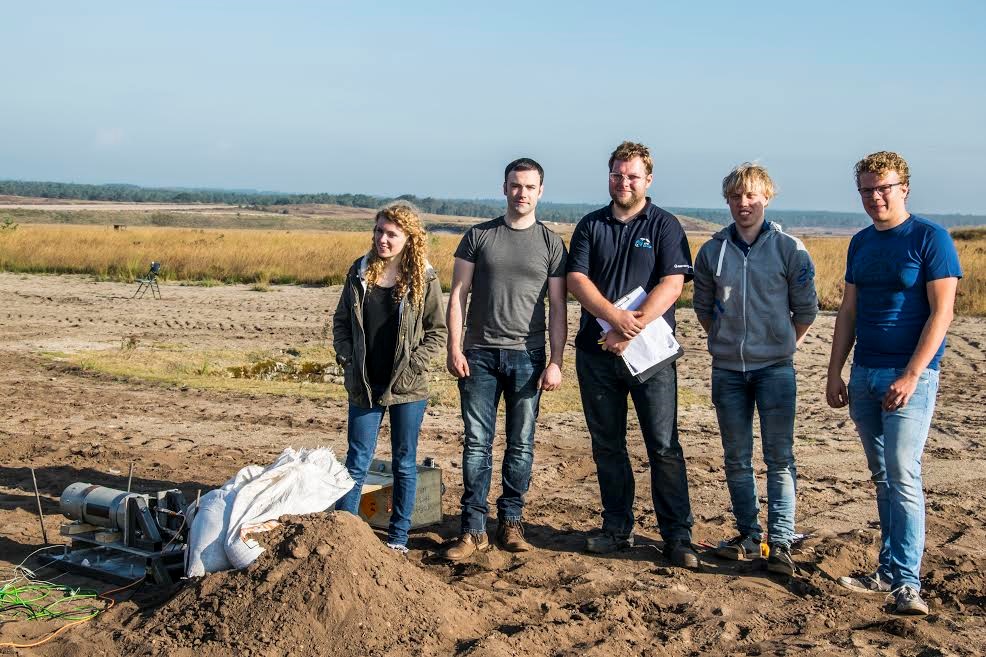
On the 23rd of September 2016, the Solid Rocket Propulsion Te am performed an engine test during the DARE launch day at ASK ‘t Harde. This was the second motor test in the test campaign of the DXS Asimov Engine, which is currently being designed as the propulsion system of Project Aether. The objective of the single-grain engine test in September was to investigate the performance of one of the seven propellant grains of the Asimov engine. The Asimov engine will be the largest solid propellant engine that DARE has ever produced, and it will be used to ensure that Aether breaks the sound barrier.
am performed an engine test during the DARE launch day at ASK ‘t Harde. This was the second motor test in the test campaign of the DXS Asimov Engine, which is currently being designed as the propulsion system of Project Aether. The objective of the single-grain engine test in September was to investigate the performance of one of the seven propellant grains of the Asimov engine. The Asimov engine will be the largest solid propellant engine that DARE has ever produced, and it will be used to ensure that Aether breaks the sound barrier.
Although the preparation of the engine test went smoothly, the test itself did not go as planned due to an instantaneous unstable combustion. Due to this non-nominal engine behavior, the Solid Rocket Propulsion Team has performed a forensic analysis to determine what happened during the test. This article presents the current progress on the forensic analysis and shows preliminary conclusions on the test campaign.
The first step in the forensic analysis was to identify all the possible failure modes. It was determined that the non-nominal engine performance was caused either due to an under performing engine casing or due to an internal pressure which was higher than the design pressure. Based on the pressure data of the test, see the figure below, it was concluded that the second failure mode was the most plausible. The engine was designed for 45 bar, and the pressure data shows that 65 bar is reached. The cause of the higher pressure is not yet known.
The nozzle’s throat cross sectional area could be a plausible reason for a manufacturing error, as this parameter has a critical influence on the internal engine pressure. However, pre-test measurements showed that the nozzle throat area was manufactured as designed and therefore this root-cause was ruled out.
Using a too large ignitor or too much ignitor fluid can also result in a rapid increase in pressure. The pressure data in the figure, however, shows a small spike just after t=0 seconds, which shows that the ignitor worked as intended and therefore the ignitor cannot be the cause of the extreme pressure build up.
Another plausible cause is that cracks in the grains occurred. Grain cracks increase the surface area, which results in a higher burn rate and therefore a high pressure. Due to the brittle nature of the grains, cracks can easily occur during the casting process or afterward if they are not handled with care. Higher quality control standards during the grain casting, handling, and transporting processes should prevent that cracks or other damages to the grains occur.
A final cause is that the actual grain performance in terms of burn rate differs from the theoretical predictions. The grains are made of “Rocket Candy”, a mixture of sorbitol and potassium nitrate, and the current burn rate of this material is based on various literature studies. To determine the exact performance of this material, the team plans to perform multiple small tests with various Rocket Candy samples to determine what their exact burn rates are.
Over the next few weeks, the Solid Propulsion Team aims to complete extra sample tests and to have a conclusive outcome as to what went wrong on the September test day. After having performed the sample tests, the team plans to perform another two single-grain tests, followed by the first full-scale motor test of the Asimov engine. Although the engine test in September did not have the preferred outcome for the Solid Propulsion Team, the results of the test are invaluable in the research to successfully making the largest solid propellant engine of DARE.


